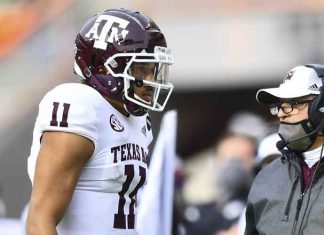SIOUX FALLS, S.D. (AP) When North Dakota State announced in August it would boost its athletic scholarships to cover expenses beyond traditional tuition, board and books, it sent shivers through the so-called second tier of college sports. Stipends were supposed to be the domain of the biggest schools as they chased top recruits and national championships.
Though two neighboring schools quickly followed the Bison’s lead, the rest of the Football Championship Subdivision world has not – at least so far. Coaches and athletic directors cite the high cost and worry about the precedent, and some say they simply don’t feel they have to do it to get top talent.
”There was not a conscious decision on our part to say let’s slow this wave,” said Montana athletic director Kent Haslam, whose Grizzlies upset then-top-ranked North Dakota State in the season opener. ”It was based on fiscal stability and being able to make this sustainable, and not just jumping because everyone else is jumping.”
A week after Montana and Montana State said they wouldn’t offer stipends, the presidents of nine FCS schools – Vermont, Delaware, New Hampshire, James Madison, VMI, William and Mary, Elon, Hofstra and Wofford – signed a letter opposing them.
Athletes have financial need, but so do their fellow students, the presidents wrote. They also said the cost could require eliminating other sports.
Haslam estimated Montana would need $600,000 to pay all athletes’ costs, and the money wasn’t there. He acknowledged stipends could help in recruiting but said many other factors go into an athlete’s choice of a school.
”Recruiting is not a level playing field anyway,” Haslam said. ”Cost of attendance just becomes one more tool to use.”
The plan to pay full college costs for athletes started with the top conferences at the larger Bowl Subdivision (FBS) level. Athletic scholarships have historically covered tuition, fees, room, board and books, but the stipends go farther in giving money that can be used to cover things such as laundry, extra food, travel home and more.
The issue may have been driven by football, but the effect and implications aren’t limited to that sport. UAB men’s basketball coach Jerod Haase is using part of his new seven-figure contract to fund stipends for both the men’s and women’s teams.
North Dakota State is the four-time defending champion at the second-tier FCS level, so its aggressiveness in launching stipends isn’t surprising. But the school is offering them across all sports, a potential recruiting boon throughout its athletic department.
In contrast to the rest of the FCS world, the Bison’s closest competitors moved immediately to match their program. In-state rival North Dakota had already offered stipends in men’s and women’s hockey, and announced it would expand to all sports. South Dakota jumped on board, with President Jim Abbott promising that donors would cover the added $300,000 to $400,000 annual expense because they ”want us to compete in everything.”
For schools weighing whether to jump into stipends, the decision likely is strongly influenced by the strength of their donor base.
North Dakota State boosters raised nearly $4 million for athletics in 2014; North Dakota’s nearly $3 million. South Dakota, home to the state’s medical and law schools, brought in nearly $4 million. All three schools are relying on donations to make the move.
South Dakota State sees itself as North Dakota State’s peer in football but has so far held off on offering stipends It’s a largely agricultural school whose annual scholarship donations in 2014 fell well behind its Dakotas colleagues at a little more than $1 million. Much of the school’s recent efforts are already earmarked for a new football stadium to open in 2016, too.
Montana and Montana State have also said no to stipends so far. They each take in between $1 million and $1.5 million in annual athletic donations.
No other Missouri Valley Football members have declared their intention to offer the stipends, said Patty Viverito, the league commissioner.
”I think everybody’s taking a wait-and-see attitude,” she said.
The first FCS school to move to stipends was Liberty, though its move attracted less attention than North Dakota State’s because Liberty had made clear its goal of eventually jumping up to the FBS. Monmouth, which competes against Liberty in football, has no interest in following Liberty or any FBS school down the stipend path, athletic director Marilyn McNeil said. It’s an institutional decision, McNeil said, but she feels stipends aren’t necessary for athletes who get opportunities far beyond those afforded typical students
”I think the student athletes are getting an extremely good deal,” she said. ”I think that if there are unmet needs, the student-athlete should consider taking out a loan like every other student in America. I think that many of their needs are being taken care of.”
Abbott, the South Dakota president, disagreed, saying most athletes just don’t have time for part-time jobs.
”You can’t exist on zero dollars,” he said. ”How do you do laundry? How do you do anything?”
Big Sky Conference Commissioner Doug Fullerton said covering an athlete’s true cost of attendance is a good idea – but they are costly.
Fullerton said that under Title IX, a school that offers stipends to a men’s program would have to do the same for the women’s program. But he envisions some schools offering stipends to some recruits within a sport but not others.
McNeil said if smaller schools are forced into offering stipends to compete for recruits, they’re going to have to find that money somewhere. Some worry that less popular sports such as men’s track and field could be targeted, and that would be bad for college athletics, she said.
”Who knows where this is going to end?” she said. ”Are we going to get into huge recruiting wars as to who’s worth what? It’s bad enough as it is.”
—-
Online:
AP College Football website: www.collegefootball.ap.org
—
Follow Dirk Lammers on Twitter at http://twitter.com/ddlammers
25% Bonus via Western Union

















